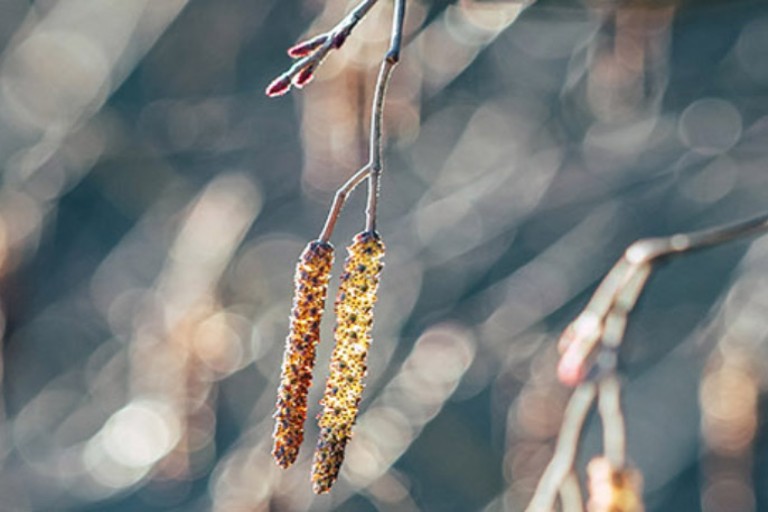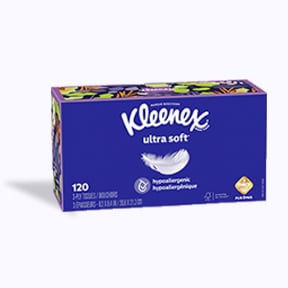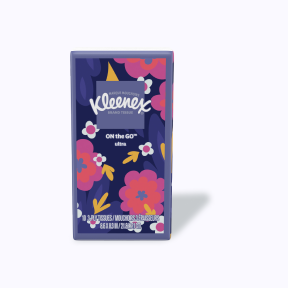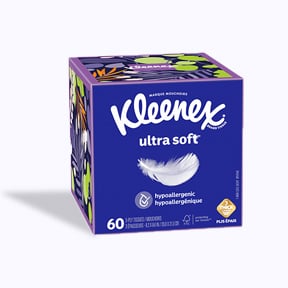
Pollen Types and Their Impact on Hay Fever
Did you know that more Canadians are allergic to pollen than any other allergen? With over 40% of the 8.4 million allergy sufferers in Canada reporting this allergy, it pays to be a pollen connoisseur. Yet, few people know the type of pollen to which they are allergic. You might know that you have a tree pollen allergy, but are you aware of which tree type you should be avoiding and when?
If you’ve already identified your pollen nemesis, why not discover your local pollen levels with our pollen tracker? It not only gives you local pollen levels, but will also tell you what type of pollen is high and when.
We’ve taken a closer look at the types of pollen out there to help you narrow down which ones will have you reaching for the Kleenex® facial tissues.
List of Pollen Types
Know your enemy. And for hay fever suffers, their foe is pollen – the fine, natural powder that helps plants to reproduce. While a lot of pollen is harmless, there are three categories that can cause nasal irritation for hay fever sufferers:
- Tree pollen
- Grass pollen
- Weed pollen
These pollen types can be carried by wind and good luck to anyone who gets in the way. For those suffering with hay fever, their bodies see these wind-borne pollen particles as an intruder and set the body to full ‘red alert’ mode.
These defences include sneezing the pollen out, watery eyes to wash the particles away, and a runny nose to clear out your nostrils. However, symptoms can vary depending on the pollen type to which you are allergic.
If you have a serious pollen allergy or severe hay fever symptoms, it might be useful to speak with your doctor or a specialist to help you identify your allergens.
Types of Tree Pollen
As you’d imagine, since this is pollen from the flowers of a tree, tree pollen has a few categories within it.
-
Ash Pollen
Ash trees thrive with a good water supply, so you can find them near water – and they’re recognized by their smooth, greyish-brown bark. For species with both male and female trees, like ash and box-elder, it is only the male tree, since they produce the pollen.
-
Alder Pollen
Alder trees like damp areas and are a yellow/red colour. Their pollen is very similar to that produced by birch. If you have noticed a reaction to birch pollen you may wish to avoid alders as well.
-
Birch Pollen
A birch pollen allergy is one of the most common. Birch pollen - which typically occurs in Canada from March through to June, peaking in April until May – can cause asthma and rhinoconjunctivitis (which is basically irritated eyes, nose and sinuses). These trees are easily identified by their white bark and can be found in lightly wooded areas.
-
Cedar Pollen
Cedar trees have blue-green needles and large, barrel like cones which grow upward on branches.
-
Elm Pollen
Elm trees have grey-brown bark, which is rough and often have suckers growing at the base of the trunk.
-
Hazel Pollen
You can spot a hazel tree by its smooth, grey-brown bark (which actually peels with age). Hazel trees are often found on the edges of wooded areas.
-
Maple Pollen
Oh Canada! Our national emblem can, unfortunately, cause allergies and due to the varieties (Sugar, Red, Douglas) has an active pollen-producing season from March right through October. Luckily maple trees are easily recognized by the shape of their leaf.
-
Mulberry Pollen
A slender, medium sized, upright tree with an open crown, mulberry trees come in red, white and black varieties.
-
Oak Pollen
This is another common hay fever allergen with symptoms including a cough, watery and itchy eyes, and an irritated throat. Look out for oak pollen symptoms during spring when it’s released into the air during its peak. "The oaks shed copious amounts of pollen, more than all other plants," according to Aerobiology Research Laboratories in Nepean, Ontario.
-
Pine Pollen
Nothing symbolizes the holidays quite like the grand Pine tree, easily recognisable by their needles!
-
Poplar Pollen
They like moist conditions, so you’re likely to find Poplar trees by water. Their bark is pale grey and has black diamond-shaped lines on it.
-
Willow Pollen
Commonly found by rivers, willows are recognisable by their long sweeping branches and slender leaves. They have been found to have a low allergenic potency – but can still cause a reaction in those unlucky few.
-
Yew Pollen
Can be identified by its small needles and red berries.
Types of Weed Pollen
Similar to tree pollen, there are a few different types of weed pollens that can trigger hay fever, including:
-
Ragweed Pollen
From August to October, ragweed is the most common cause of allergies. Producing copious amounts of pollen, ragweed is an upright plant which, when looked at closely (though not too closely if you’re allergic!), has leaves that are fern-like.
-
Nettle Pollen
A very common weed, nettle pollen actually causes few allergies (but are known for horrible stings).
-
Dock Pollen
Found in meadows and some coastal areas, the pollen this produces can cause common hay fever symptoms (but they can also help soothe a nettle sting).
-
Mugwort Pollen
With the ability to grow over two metres, you’ll be able to spot mugwort by its red/brown colour and small flowers.
-
Plantain Pollen
Not to be confused with the delicious banana like fruit, this is a short plant and its leaves are usually found growing directly from the soil.
Grass Pollen Season
Grass pollen is thought to be one of the worst offenders when it comes to hay fever. This allergy takes the lead at the beginning of summer (June to July) – just as tree pollen starts to ease up – and tapers off with the warm weather during August or September. Needless to say, it’ll be a long sneezy summer for hay fever sufferers.
Since grasses tend to have lower pollen counts, hay fever symptoms may not be as severe as they would be with trees or ragweed. Unfortunately, pollination generally lasts longer with grasses, so those runny noses and watery eyes may stick around for more time.
Common grass pollen allergy symptoms include irritated eyes, throat and nose. However, some other symptoms such as contact dermatitis (a form of eczema) and headaches can occur in people with severe allergies.
You may notice an increase in symptoms if you are around grass for long periods of time or when you cut the grass. Wearing a highly protective mask can actually help with some hay fever symptoms.
Check out our pollen calendar to see which pollen appears when, or click on Your Pollen Pal for your local pollen forecast.
Throughout pollen season you’ll want to ensure you have Canada's softest tissues around your home for everyday comfort! From watery eyes to sensitive noses Kleenex® 3-layer Ultra Soft™ facial tissues softly comforts skin, so you can get back to enjoying your summer to the fullest. Keep a box of Kleenex® Ultra Soft™ facial tissues in the kitchen, living room, office, bathroom, bedroom and guest room to make sure the softest comfort for your nose is always at arm’s reach!






